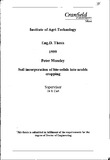JavaScript is disabled for your browser. Some features of this site may not work without it.
| dc.contributor.advisor | Earl, R. | |
| dc.contributor.author | Moseley, Peter | |
| dc.date.accessioned | 2017-08-23T09:17:18Z | |
| dc.date.available | 2017-08-23T09:17:18Z | |
| dc.date.issued | 1999 | |
| dc.identifier.uri | http://dspace.lib.cranfield.ac.uk/handle/1826/12367 | |
| dc.description.abstract | "The application of bio-solids to established arable crops, using shallow injection techniques developed during this study, is feasible in environmental, economic,agronomic and engineering terms." Novel approaches to bio-solids disposal and recycling are required to compensate for expected increases in production, and to alleviate the extemal pressures exerted on the water company through legislation and increased public awareness of environmental issues. A review of previous work has identied bio-solids application to arable cropping as a promising benecial outlet for increased volumes of waste. From this doctoral study, in collaboration with a parallel fast track project, a improved, shallow injection system has been developed, based on soil mechanics theory and extensive laboratory and field testing. Environmental pollution, in terms of odour and ammonia emissions, may be signicantly reduced through the use of this system, when compared to other shallow injection or surface application methods. Nitrate leaching was found to be unaffected by the increased retention of valuable nutrients under field conditions prevailing during the study period, and no detrimental effect on agronomic performance has been identied following application to crops up to three months prior to harvest. Economically, a market exists for this technology, through the enhanced nutrient value of the bio-solids product. However, product quality, consistency and other enviromnental issues require solutions before the full economic benefits and market acceptance can be realised. Theoretically, the increased application "window of opportunity" has the potential to increase producers operating profits substantially (1.7%/yr, Anglian Water Services Region) through reduced inventory, storage and distribution costs. Maximisation of enviromnental benefits has been addressed in terms of implement control, by maintaining constant tine attitude to the soil, through a parallel linkage system. A analysis of the force system associated with the parallel lirkage system, in conjunction with the development of a model to predict tine depth, was used to examine ways of optimising the dynamic performance of the system. This work demonstrated that geometric changes to the parallel linkage are unlikely to affect dynamic performance. However, the use of frictionless linkage joints in conjunction with depth control skids was shown to improve dynamic performance signicantly and a novel multiple curve fitting technique was developed to improve the accuracy of the depth prediction model. | en_UK |
| dc.language.iso | en | en_UK |
| dc.publisher | Cranfield University | en_UK |
| dc.rights | © Cranfield University, 1999. All rights reserved. No part of this publication may be reproduced without the written permission of the copyright holder. | en_UK |
| dc.title | Soil incorporation of bio-solids into arable cropping | en_UK |
| dc.type | Thesis or dissertation | en_UK |
| dc.type.qualificationlevel | Doctoral | en_UK |
| dc.type.qualificationname | EngD | en_UK |

